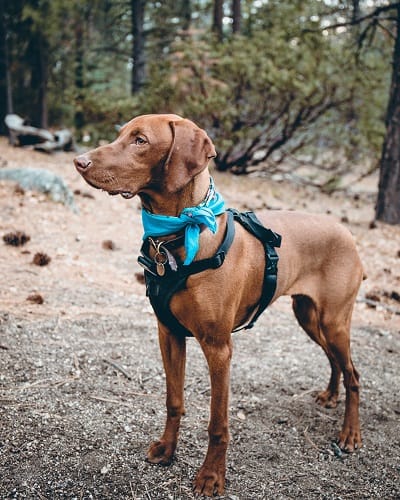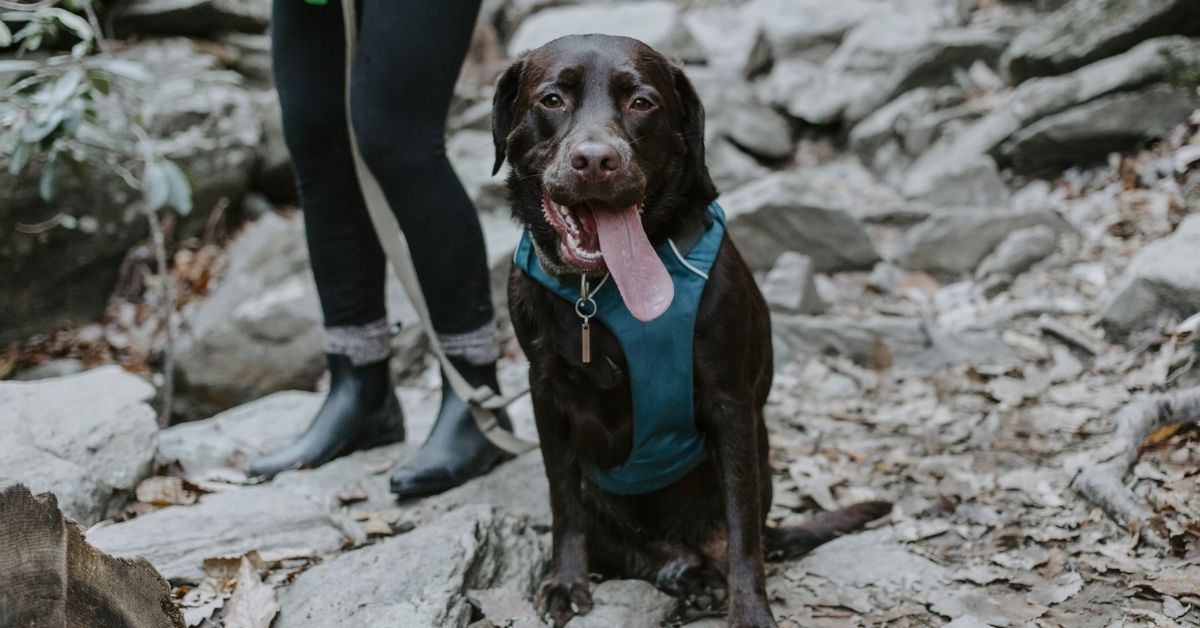Are you an avid hiker who loves the idea of hiking with dogs along for the journey?
Dogs can be excellent company in the outdoors, and exploring with your furry friend can be a wonderful bonding experience full of fun.
Whether you venture out on an easy 1-mile trail or a more rugged 10-mile journey, your dog will love spending time outdoors with you – and will reap the benefits of the fresh air and exercise.
But the length of your hikes is often the first question to ponder when planning a hiking with your dog — from what type of dog can keep up, what to pack for the trek, and how many miles can a dog hike to how to prepare your dog for hiking.
Planning ahead is essential if you want you and your pup to be perfect trail buddies.
Hiking with Dogs: Is Your Dog Ready to Be Your Hiking Companion?
How Physically Fit is Your Dog?
Hiking is more strenuous than just walking, with uneven terrain and sometimes steep climbs.
If your dog is most used to relaxing on the couch or just casual strolls around the block, then a 10-mile hike is not going to be fun for either of you – unless of course you enjoy carrying your pup!
Make an honest assessment of your dog’s fitness level to be sure he can go the length and level of hike you’re wanting to go on.
Before embarking on your first long trek, practice by taking small hikes ahead of time and build up to longer trips.

Just like you wouldn’t go from being completely sedentary to running a 10k, neither should your dog.
Not only will this training help you monitor your dog’s response to the activity, but it can help toughen up his paws or get her ready to wear doggie hiking booties.
And, if you plan on having your pup carry his supplies in a dogpack, use these training sessions to know which pack fits the best and how much he can carry.
Don’t Miss: How to Camp With a Dog?
Knowing your dog – and yourself – will provide you with the best information to say how long you and your companion can hike safely without being completely sore the next day.
Ten miles is a lot for most people and dogs, but some push it to 15-20 miles a day.
How is Your Dog’s Behavior?
She needs to know easy commands such as heel, sit, stay, and come – and be more interested in staying with you than chasing squirrels.
It’s not safe for either you or your pup to trek rugged trails tethered to a leash the entire time, so you’ll need to be certain he’s able to be trusted off the leash at times – but please follow your local trail’s leash rules.
And, if you’re hitting a busy trail, you’ll be close to other people and pets, so being friendly, sociable and not prone to barking is a must.
How Big or Small is Your Dog?
Assuming your dog is physically fit and well-mannered, almost any size of dog should be good with hiking.
With proper conditioning, smaller dogs may do just as well as larger dogs.
Do keep in mind, though, that smaller dogs will have to move their legs a lot more to keep up than a larger dog will, and they’ll also possibly need a lift up/down steeper terrain.
There are options for carrying your pup instead so make sure to check out our list of the top 5 dog carriers for hiking.
How Old is Your Dog?
This should also be taken into account when thinking how far and long your dog can hike in a day.
Dogs under a year old can have a hard time keeping up, but might be ok with hikes shorter than one hour to start.
It’s also probably a good idea to wait until your puppy has received all her shots before hitting the trails. And, with their bodies still maturing, too much stress could cause lasting joint issues on their developing bodies.
The same applies in reverse with older dogs.
If your sidekick has shown signs of slowing down, has trouble getting up and down stairs and furniture, then it might be time to consider leaving him at home for your next hike.
Signs You’ve Gone Too Far
It’s normal for dogs to pant a little and breathe a little heavier than usual – just like we do during a workout (or is that just me?).
But, there are signs to watch for to know when enough is too much.
- Excessive panting – often with a distended tongue.
- Very heavy breathing – If your pup is breathing heavy along with heaving, or if her breathing doesn’t go back to normal after a 15-minute break, then she’s done for the day.
- Walking slower – Most dogs want to be right beside their humans or a smidge in front. So, if your dog has fallen behind, then it’s time to turn around or be on your way back.
- Getting wobbly on their feet and possibly losing their balance.
- Limping or Lameness – If your pup is limping, check their paws for any cuts, but it’s possible they strained something from over-use.
- Licking feet – are his pad’s injured or irritated?
- A tucked tail – it might be time for a break if your pup’s tail isn’t up and wagging.
Keep in mind, a lot of dogs will keep going and going whether they are tired or not. It’s up to you to say enough is enough.
Heat and terrain are the two biggest factors in how far your dog can go – the hotter it is and/or the steeper the terrain, the less distance you’ll be able to safely trek.
How Do I Protect My Dog’s Paws When Hiking?
Your dog’s paws are extremely delicate – this is especially true for dogs who spend most of their time indoors.
If you plan on hiking over rocks that could be sharp, in super cold snow, or in temperatures above 70°F, it might be best to invest in a pair of doggie booties to protect their paws from cuts and scrapes.
Look for a boot that will snugly fit the paw. Something too small will cut off circulation, but too large could rub the paw and cause sores.
Allow your pup some time to adjust to wearing the boots before going out on a long hike. Some dogs are resistant.
If you don’t have boots, or your dog won’t tolerate them being on, start small with your hikes. Their paws will toughen over time.
While hiking, be sure to stop and check their paws regularly for cuts, scrapes, bruises or rocks stuck between their toes.
If you notice any cuts, keep it clean with water, disinfectant and gauze from the first aid pack, then watch for signs of infection once you get home.
While you want your dog to have tough paws, you don’t want them to get too dry or they will be more susceptible to cracking, peeling and cuts.
Consider moisturizing your dog’s pads daily, especially in hot weather, to help prevent injuries and burns. Look for a treatment that is safe for dogs to lick.
Paw wax is another treatment to protect your pup from rough or hot surfaces.
Safety Tips for Hiking With Your Dog, Before Heading Out & About
- Make sure that your dog is up to date on his vaccinations and has a clear bill of health from your vet
- Ensure that your dog has a rabies tag on him
- Make certain that your contact info is on his collar or he’s microchipped
- Confirm that your dog is free of any open wounds that could be vulnerable to infection
- Make sure that your dog is current on necessary preventatives for fleas, ticks, and heartworms
- Do locate the nearest emergency vet clinic, just in case of any serious injury or illness while you’re out and about
15 Vital Tools of the Trade: What to Pack for Hiking With Your Dog
1. Water for both you and your companion
Overestimate how much water you’ll need, and bring along a silicone collapsible bowl to make drinking easy for your dog.
You’ll want to keep your pup from drinking from natural water sources in case of harmful organisms, so bringing water on your trek is of utmost importance.
2. Plenty of food for you and your dog
Opt for dry food with high protein and fat content. Bring treats/snacks in addition to their regular meals needed – they’ll need the extra calories from their extra exertion.
3. First aid kit
Basic first aid kit, including items such as disinfectant, gauze, bandaging material, liquid bandage for cut paws, tweezers, scissors, insect repellent, cortisone, vaseline to coat their paws, sunscreen, and hydrogen peroxide to induce vomiting if they’ve eaten something they shouldn’t have.
4. A backpack – for you and your pup
Your dog will love carrying some of his own goodies. A general rule is to keep the backpack at 15-25% or less of your pup’s body weight. Here are our favorite backpacks for dogs…
5. Leash/harness
Be sure to include a leash/harness, even if the trail allows for your dog to be off his leash, it’s still important to bring it just in case your dog isn’t having a good listening day.
And, some parks require a leash that is 10 feet or shorter in length, so pay attention to the rules/regulations of where you’re going.
ALSO READ: The 5 Best Dog Harnesses for Hiking
10. Poop bags
Even though you’ll be “in the wilderness,” it’s proper etiquette to pick up your dog’s poop to prevent other hikers from having a misstep or offset the natural fauna of the forest.
11. Dog brush
A dog brush is essential if your furry friend is a long-haired breed – especially if you know your pup is particular about how knotted his fur gets!
12. Dog boots
Dog booties will protect sensitive paws or in the event of a tear or cut. It’s not uncommon to lose one on the trail, so bringing an extra set is also a good idea.
13. Towel
Your pup might get wet and muddy, so a towel to wipe off before getting back in the car or tent is a great idea.
14. Sleeping Pad
If you’ll be spending the night at a campsite, also bring along a sleeping pad or blanket, a towel in case they get wet, and a flashlight or glowstick to help see in the dark.
15. Camera
I’m sure that you’ll want to treasure these memories, so a camera is an essential.
Trail Etiquette
Proper trail etiquette is one of the most important things when hiking—besides having fun and staying safe.
Put simply, trail etiquette is not only respecting the land you are on, but also the people you are around.
Let’s look into some helpful tips when hiking with your furry friend:
- As always, be sure to research the rules and regulations of your destination in advance to make sure the trails and campsites are dog-friendly and safe. Are dogs allowed off leash? Are there leash size restrictions? Most U.S. National Parks do not even allow dogs when on a leash, and some state parks and national forests have regulations on leash size. Knowing the trail etiquette is one of the most important tips, allowing you and your dog to maintain friendly relationships with other hikers.
- Research the actual trail topography as well. A lot of planned hikes are marked with a difficulty level, so keep in mind your capabilities when selecting which path to take.
- Look at the weather. Keep an eye out for any approaching storms, and steer clear of super hot and humid days.
- Check for ticks, fleas and poison ivy during breaks along your trek and as soon as you’re done – you’ll want to take care of these right away.
- Give dog-less hikers the right of way. Step out of the way and tell your dog to sit while the other hikers pass while you give a friendly hello to assure them your dog is a friend to other humans.
- If you see a dog off his leash, put your dog back on his leash before allowing the two to meet.
- Don’t try to manage more than one dog by yourself; keep a 1:1 human to dog ratio. Also, no matter how many humans you have in your group, keep it to a two dog maximum to avoid becoming a pack, which would be harder to manage and more intimidating for other hikers and their pets.
What Are the Best Dog Breeds for Hiking?
If you know you love to hit the trails and are looking for a forever friend, here are just a few of the breeds most suited for hiking.
Bernese Mountain Dog
Big and strong, these dogs can help carry their own supplies, and do great in cooler to cold climates. But, be cautious in warmer climates.
They’re also very bonded with their family and naturally well-mannered with strangers, so they make a dream hiking dog.
Siberian Husky
Powerfully built with lively spirits, these dogs are always ready for adventure. Huskies are perfect for the colder weather, but won’t do so well in extreme heat.
They are very focused work partners with loads of endurance, and are gentle and loving when it comes time to rest. They do love to run, though, so be wary about letting her off her leash.
Australian Shepherd
Intelligent and adventurous with boundless energy equals are perfect breed for long hikes. And, their agility will do well over most moderate climbing trails.
They’re also well-suited for most climates, except the absolute extremes.
Vizsla
With great endurance and strength, Vizslas make excellent hiking partners, especially since they require plenty of physical exercise and attention.
They are stubborn and independent, though, so proper training is essential.
Labrador Retriever
America’s favorite dog breed is smart, trainable, strong and hard working, which equals a perfect hiking partner. Plus, labs perform well in most climates, as long as they aren’t too extreme.
They can also carry some gear and will be happy to help – and will make plenty of friends along the trail.
Portuguese Water Dog
Whether by a mountain lake or a rushing river or a small creek, your affectionate and adventurous Portuguese Water Dog will love hiking along the water and other trails.
German Shorthaired Pointer
Similar to labs, only slightly more difficult to train, but with even more energy (how is that possible!).
They do have a very strong prey drive, though, so woodland creatures like rabbits and squirrels may send them off on a rush.
Rhodesian Ridgeback
Originally bred to hunt lions, these dogs are fearless protectors, so if you don’t like to follow trails, your four-legged friend will protect you from any outdoor threats.
Border Collie
This breed lives to work, so don’t worry about giving your friend some tasks along the way – have him carry supplies, retrieve a stick, etc.
They’re the smartest dogs in the world and have boundless energy. They’re especially great for overnight camping hikes, and can even be trained to collect you firewood.
Weimaraner
No matter how long you plan to hike, this trusty companion will keep up with you just fine.
The Mutt
If your best friend is a rescue and you’re not quite sure his full heritage – he’s probably still a great hiking companion.
Keep in mind his energy and strength levels to keep up, and make sure he’s trained well enough to obey your simple commands – especially coming to you with distractions around.
Also keep in mind genetic makeup.
Just because your dog may be small doesn’t mean he can’t be a good hiking partner.
But dogs with short, stubby legs will tire out faster than others, as will dogs with short snouts that can’t breathe as well when exerted.
Best Small Dog Breeds for Hiking
Jack Russell Terrier
While he’s the smallest on our list, he’s full of energy and if trained well, will work hard and won’t stray too far from your side the entire trek.
Not a great guard dog for protection of wildlife, but they will alert you of upcoming dangers with their bark.
Rat Terrier
Very similar to the Jack Russell, except without the strong bark. Bred to hunt rodents, don’t be shocked if she takes off after a small treat.
Beagle
Small, but sturdy and strong who love to explore, learn and be with their people and new friends.
Their nose leads their moves, so keep in mind your dog’s obedience level before trusting him on a hike.
Wrapping it pUp
There is nothing like the experience of being outdoors to refresh you mind and body. Our pups get the same enjoyment we do and bringing them along for this journey will only strengthen your bond.

Make sure your best friend is up for the challenge before [em]barking on your trail adventure.
Take the necessary precautions to ensure both of you come back home safely and excited to do this all over again!







